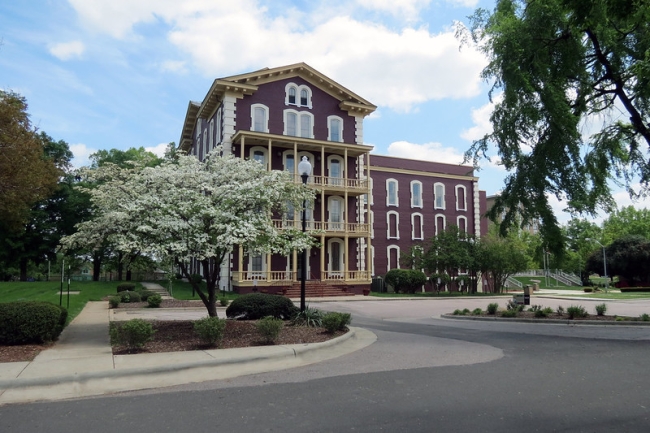You have /5 articles left.
Sign up for a free account or log in.

Estey Hall at Shaw University
Courtesy of Shaw University
The CEO of Netflix and his wife donated $120 million to Spelman College, Morehouse College and the United Negro College Fund in June.
The donation rekindled old discussions among historically Black colleges and universities, or HBCUs, about who gets large gifts, who doesn't and why. It also coincided with a pandemic-fueled recession that is rocking all of higher education, but particularly HBCUs, which are generally less resourced and have smaller endowments.
"For someone who has a lot of money and wants to make a donation, a lot of times in the United States, we tend to invest more in what we see as the winners," said Ivory Toldson, professor of counseling psychology at Howard University and president of the Quality Education for Minorities Network, a nonprofit focused on improving education for underrepresented students.
The issue turns into one of meritocracy versus charity, Toldson said.
Across higher education, colleges that hold more prestige tend to get the most donations, said Gregory Price, professor of economics at the University of New Orleans.
"You see the same thing in Black colleges -- they’re known, they’re highly visible," he said. "So if you want to make a high philanthropic mark, you give to those."
The inclusion of UNCF, a nonprofit that advocates for its 37 member HBCUs, in the donation is a promising sign, though, Price said. It's an attempt to spread the wealth, and while $40 million across 37 colleges is not a large sum, "it's a start," he said.
UNCF hasn't finalized the distribution of the funds yet, said Brian Bridges, vice president of research and member engagement at the college fund.
The issue of giving to institutions that have more money is not restricted to HBCUs, he said. And perhaps the biggest challenge for the sector is attracting megadonors.
"The people who are able to give seven-, eight- or nine-figure gifts -- small HBCUs, community colleges, any small institutions outside of the New England elites, simply don't have access to those individuals," Bridges said.
In the current environment, philanthropy is more crucial than ever. Some HBCUs are already on the brink of closure, Price said, and many were financially fragile before the COVID-19 pandemic hit.
"This might tip some over the edge," he said. "That’s an unfortunate reality, unless they get a big gift."
But Toldson believes HBCUs will continue to be resilient in the face of the novel coronavirus, as they have in past crises.
"Every time something happens, there seems to be a glib anticipation of HBCUs closing. I don’t know if that type of dialogue is beneficial to HBCUs," he said. "HBCUs need more support, generally, compared to other institutions in times of crisis and in normal times. They’re institutions that have taken on this historic mission of taking care of those who have less."
But, he added, "notwithstanding some of the financial challenges, they have proved themselves to be very resilient. With COVID-19, I don’t expect anything less than more resilience."
Bigger Gap With the Wealthiest Colleges
Getting more and bigger donations requires institutions to act as their own salespeople, which can be difficult, Price said.
That's the strategy that Paulette Dillard, president of Shaw University, is trying to take. But often money is needed to make money.
"The reasons those institutions attract funding at a higher rate and are more visible is simply because they are much better funded than some of the rest of us," Dillard said. "With higher visibility comes people wanting to back a winner."
Shaw is trying to increase its endowment, but it is working on a "shoestring budget," she said. About 80 percent of students at the private liberal arts college are eligible to receive federal Pell Grants, compared to about 40 percent of the total undergraduate population across higher education.
While Shaw is a tuition-driven institution, it also has to keep prices low to serve its population, Dillard said. The university is using social media and other platforms to establish a brand identity. Dillard hopes Shaw's history as the first HBCU in the southern states will attract more attention -- and donors.
"We are lovingly known as the mother of the other HBCUs," she said, because graduates of the university went on to found other HBCUs in the South. "If all of us could tell our stories to the right audience and people can see what a difference we’ve made with very little, imagine what we could do with a sizable investment."
While it's been a struggle in recent years for Shaw to continue serving its population, Dillard said, the conversation shouldn't be about rich HBCUs versus less-resourced HBCUs. The more well-known and well-resourced HBCUs, like Howard University and Morehouse, have endowments that still are only a small fraction of those held by universities such as Harvard or Stanford. Shaw has an endowment of about $10.7 million.
"I am just trying every day to create opportunities to tell the Shaw story, to attract the kind of investment that will put Shaw on the radar screen again," she said. "And I’m sure many of my colleagues in the smaller institutions are doing the same thing."
Kayla Elliott, senior policy analyst for higher education at the Education Trust, understands the frustration some may feel when hearing about the same few institutions receiving large gifts many times over. But the disparities within the HBCU sector pale in comparison to the disparities between HBCUs and predominantly white institutions, she said.
And for public HBCUs, state and federal governments have the responsibility to provide them with adequate resources, said Elliott.
"It speaks volumes that institutions that overwhelmingly serve low-income and Black students have been underfunded for decades and have still continued to overproduce Black graduates," she said.
Private HBCUs also face disparities. The cumulative endowment holdings for the HBCU sector is $2.1 billion, Elliott said. More than 50 predominantly white institutions on their own have more in endowment funds.
The Education Trust advocates for the federal government to increase funding to Title III-B institutions, which specifically targets HBCUs, as well as to provide additional funding to help colleges weather the pandemic. Other solutions could be requiring well-resourced institutions to put a certain percentage of their endowment funds toward helping low-income students, as well as asking institutions to be more transparent about where their endowment money goes.
Advocates and associations could also provide more equity-focused guidance for donors and ask them to spend more time thinking about what's important to them, to guide where they should give, Elliott said.
"I think HBCUs are invaluable," she said. "The impact that they have on their local communities, as well as on the generational wealth and opportunities for Black Americans, is irreplaceable."




